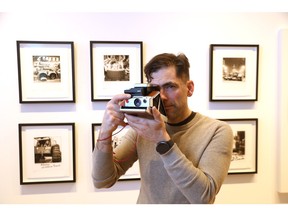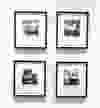Reviews and recommendations are unbiased and products are independently selected. Postmedia may earn an affiliate commission from purchases made through links on this page.
Art
Sussex Drive art gallery showing photo exhibit of the ‘hidden beauty’ of convoy protesters
A press release from photographer Paul Ozzello and Art + Galerie calls the images “both striking and controversial,”

A Montreal photographer who says he found “hidden beauty” when he visited last year’s convoy protest in Ottawa is exhibiting his portraits of protesters at a Sussex Drive gallery, coinciding with the occupation’s first anniversary.
“We are taking absolutely no political stance on this show whatsoever,” Bex said. The show is entitled “Fringe.”
Bex acknowledged that the occupation “was a polarizing event for sure.” But he contended that Ozzello’s photo have artistic merit. “At the end of the day, they’re really nice pictures, really well presented,” Bex said.
Ozzello said he came to Ottawa soon after the trucks arrived and stayed for two weeks in a motel, drawn to document the event. He returned a few more times until the protesters were forced to leave.
“I search for hidden beauty… that often goes unnoticed, and when I came to Ottawa, I found a similar beauty in the spirit of those Canadian truckers,” said Ozzello in response to emailed questions.
“I know talk of the truckers can be very triggering to some and I hope my less critical viewpoint of the protest isn’t a complete turn-off,” Ozzello said. “This is coming from someone double-jabbed who sewed several thousand masks for my doctor friends at the beginning of the pandemic.

“There was something romantic to seeing these primal men and women getting together to defy the government and stand up for what they believe, and I wanted to convey this more human side of the truckers,” he continued. “They had this quixotic grunginess that I love to photograph.
“When one of them saw my old Polaroid camera, he asked me to take a photograph of him – then took out a Sharpie and signed the print,” Ozzello said. “And that’s how it all started.”
He said he was apprehensive about meeting people who were violent extremists, but that wasn’t his experience.
“I eventually started talking to many of the truckers and realized that these people really weren’t much different from myself,” Ozzello said.
“These were just ordinary Canadians that were tired of being confined, afraid of what long term side-effects of the vaccine might be, that just wanted to return to a normal life.”
“Journalists have received death threats littered with racist epithets. Others have been spat on and verbally and physically harassed. In another case, the windows of a CBC/Radio-Canada news cruiser were broken,” said a Jan. 28, 2022 press release from the CAJ.
Veteran Ottawa photographer Paul Couvrette, who lives and works in Centretown, said he too visited the convoy protest several times out of curiosity and that he took “thousands” of photos.
“I had at least two or three people threaten me,” Couvrette said. “I did have people tell me, ‘Put the camera away, delete all the pictures.’ I’ve been around enough that that didn’t bother me.”
He added that after his first few visits to the protests, he returned with a large Canadian flag on his backpack and was greeted as an ally. “Suddenly people went, ‘He’s one of us.’ It was an us-and-them thing.”
“I disagree with 99 per cent of what the convoy people wanted,” Couvrette said. But he called Ozzello’s sympathetic portrayal “valid.”
Said Couvrette: “The photographer is going to focus on the human side and there is a human side.”

Art
40 Random Bits of Trivia About Artists and the Artsy Art That They Articulate – Cracked.com
[unable to retrieve full-text content]
40 Random Bits of Trivia About Artists and the Artsy Art That They Articulate Cracked.com

Source link
Art
John Little, whose paintings showed the raw side of Montreal, dies at 96 – CBC.ca
[unable to retrieve full-text content]
John Little, whose paintings showed the raw side of Montreal, dies at 96 CBC.ca

Source link
Art
A misspelled memorial to the Brontë sisters gets its dots back at last

LONDON (AP) — With a few daubs of a paintbrush, the Brontë sisters have got their dots back.
More than eight decades after it was installed, a memorial to the three 19th-century sibling novelists in London’s Westminster Abbey was amended Thursday to restore the diaereses – the two dots over the e in their surname.
The dots — which indicate that the name is pronounced “brontay” rather than “bront” — were omitted when the stone tablet commemorating Charlotte, Emily and Anne was erected in the abbey’s Poets’ Corner in October 1939, just after the outbreak of World War II.
They were restored after Brontë historian Sharon Wright, editor of the Brontë Society Gazette, raised the issue with Dean of Westminster David Hoyle. The abbey asked its stonemason to tap in the dots and its conservator to paint them.
“There’s no paper record for anyone complaining about this or mentioning this, so I just wanted to put it right, really,” Wright said. “These three Yorkshire women deserve their place here, but they also deserve to have their name spelled correctly.”
It’s believed the writers’ Irish father Patrick changed the spelling of his surname from Brunty or Prunty when he went to university in England.
Raised on the wild Yorkshire moors, all three sisters died before they were 40, leaving enduring novels including Charlotte’s “Jane Eyre,” Emily’s “Wuthering Heights” and Anne’s “The Tenant of Wildfell Hall.”
Rebecca Yorke, director of the Brontë Society, welcomed the restoration.
“As the Brontës and their work are loved and respected all over the world, it’s entirely appropriate that their name is spelled correctly on their memorial,” she said.
The Canadian Press. All rights reserved.
-

 News20 hours ago
News20 hours ago‘I get goosebumps’: Canadians across the country mark Remembrance Day
-

 News20 hours ago
News20 hours agoSurrey police transition deal still in works, less than three weeks before handover
-

 News18 hours ago
News18 hours agoFrom transmission to symptoms, what to know about avian flu after B.C. case
-

 News19 hours ago
News19 hours agoBitcoin has topped $87,000 for a new record high. What to know about crypto’s post-election rally
-

 News18 hours ago
News18 hours agoWisconsin Supreme Court grapples with whether state’s 175-year-old abortion ban is valid
-

 News20 hours ago
News20 hours agoTwin port shutdowns risk more damage to Canadian economy: business groups
-

 News8 hours ago
News8 hours agoCanadanewsmedia news November 12, 2024: Union serves strike notice to Canada Post
-

 News8 hours ago
News8 hours agoAs Toronto enters its Taylor Swift era, experts say crowd safety depends on planning





















